Future Now
The IFTF Blog
Café Hyène: A Speculative Dining Experience in 2025
#10YF2015
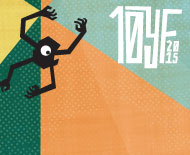
At IFTF's 2015 Ten-Year Forecast, our Food Futures Lab explored the microbial future, how emerging breakthroughs at the intersection of technology, the agriculture and food industry, citizen science, and the culinary arts will reinvent our global food system and our world.
The future of food is often cast as a problem of scale—the problem of feeding the 8 billion people we’ll be in 2025. But as we manage our food and water systems to the microbial level, as we enter an era of intentional biology, we confront the fundamental qualities of these resources. As we transition from a world where microbes are the enemy to be eradicated to one where the living qualities of food and water take center stage, we’ll have to rethink every system—from soil to the social breaking of bread—to grapple with the dilemmas of quantity versus quality and of access versus stewardship.
What might dining look like in the face of these dilemmas?
At the opening night of the Ten-Year Forecast retreat, Rebecca Chesney I and invited participants to join us on stage alongside chef and Future for Good Fellow, Tim West, to partake in an eating experience unlike anything they'd seen before—a live performance scenario of a possible dining experience in 2025. The idea came from The Human Hyena Project, a speculative design project from artist Paul Gong from the Royal College of Art in London. We are incredibly grateful to Paul for his creative work and for sending us a set of his designs for our performance.
IFTF included signals from today that build a story of how we might possibly arrive at the future Paul imagines in his project. IFTF’s Food Futures Lab is tracking these signals as transformations that will reshape food experiences, values, and products and services in the next ten years.
Picture yourself at the grand opening of Café Hyène in 2025...
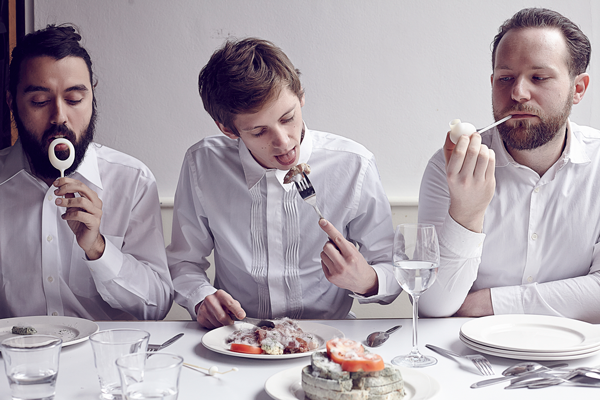
Thank you all for joining us this evening! We were really overwhelmed at the enthusiasm of responses, and we are thrilled to have this special group here with us tonight. The grand opening of Café Hyène has been about a decade in the making and tonight’s tasting menu is sure to push the boundaries of culinary arts and science beyond anything you’ve ever experienced before.
You all are the first people in the world to share this dining experience. We want to give you a little bit of a peek into how we got here.
Think back to where you were in the spring of 2015. Chefs had already started seeing themselves as essential changemakers in the food system, tackling some of our biggest challenges, from food waste to sustainable agriculture and obesity.
Food waste drove new eating experiences
Food waste was one of the biggest challenges of the decade from 2015 to 2025. In 2015, the average American family tossed out over 1,000 pounds of food every year, and the USDA estimated that 30-40% of our total food supply was wasted. In 2015, Chef Dan Barber launched wastED, a pop-up restaurant that the New York Times called “a high profile experiment in wasting nothing.” He worked with dozens of other celebrity chefs to create beautiful delicious dishes out of often ignored or un-coveted ingredients.
And you’ve all heard of the Real Junk Food Project, which now runs over 50 cafes across England that serve delicious casseroles, perhaps like your mother used to make—except these are prepared foods foraged from dumpsters. The Real Junk Food Project is perhaps the only restaurant chain in the world with the goal of making itself unnecessary and obsolete as food waste is eliminated.
And you’ll remember the roadkill craze that developed after Modern Farmer called it the most ethical meat. Even though we salvaged just one third of deer meat killed on the roads, we gained 20 million pounds of venison in our food supply.
People began eating to alter their microbiomes through food
But even as people at that time worked to change the cultural perception of what food was acceptable to eat, and what is real food, others were seeing if we could expand what was scientifically possible to eat. Many of these projects got their start as we gained a better understanding of the link between the bacteria living in our guts and our ability to digest various foods.
A 2010 study between a group of Japanese and American volunteers found that the Japanese group carry a gut bacteria that helps them extract nutrients from seaweed. The researchers found that the bacteria in the Japanese guts borrow genes from an ocean bacteria found in nori, the dried seaweed product used to wrap sushi. This gene transfer helps these humans digest molecules in the seaweed that they otherwise could not digest. This was one of the first studies to show a clear link between microbes in the food we eat and the microbes in our bodies, and also showed the potential for us to use our diets to manage our own microbiomes.
We started to understand that, when we eat, we not only want to get the most for our human selves—we are also feeding our bacteria. People started to engineer their microbiomes for different effects through foods they eat.
Synthetic biology introduced new tools to recreate common foods
People also started to use the tools of synthetic biology to recreate common foods in more sustainable ways. Many biohacker groups and startups experimented with genetically modifying yeast to produce milk proteins more sustainably than the traditional model, which uses a cow.
Two groups in the San Francisco Bay Area, Muufri and crowd-funded Real Vegan Cheese Project, both worked with this process to essentially brew cow’s milk, similar to the process for brewing beer.
As these technologies become better understood and more prevalent in grocery stores and restaurants, the initial distrust quickly wore off and chefs and consumers alike embraced the potential for creative experimentation with synthetic biology to address the sustainability of our food system— and perhaps even create foods that were once inedible for humans.
As we celebrate the opening of Café Hyène today, we also mark the ten-year anniversary of the Bistro In Vitro. On May 6, 2015, the world’s first in vitro meat restaurant opened its doors in the Netherlands. Here you see their signature meat cocktail, a meat-based riff on the classic white russian. The restaurant is based on the first in vitro meat cookbook, released in 2014.
Now, in 2025, we are ready for Café Hyène
Our technologies and culinary creativity have come a long way since 2015, but we unfortunately still face food waste while people around the world go hungry. We have further to go, and tonight we’re going to take you where you have never been before.
The original idea for Café Hyène came from an artist in London named Paul Gong, and we express our deepest gratitude for his visionary creativity which will set a precedent for how fine dining can help us tackle these big food challenges and create what is sure to be one of the Bay Area’s most highly praised gastronomical experiences.
As we entered an era of intentional biology, Paul was brave enough to ask this most essential question: could we use synthetic biology to alter our gut microbes so that we can digest rotting foods like a hyena?
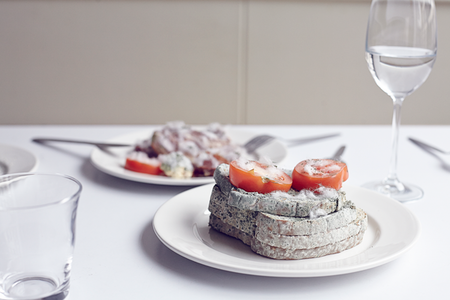
Transhumanists, DIY biology enthusiasts, and makers came together to form a group known as Human Hyenas. They wanted to tackle the problem of food waste in a radically new way: by using their own bodies as a tool for doing something about larger issues. This group shifted the paradigm from modifying environments to suit our own human demands for more food to modifying their own bodies to account for the environmental constraints our food system faces.
Tonight you will be the first to use an exclusive set of dining utensils designed just for Human Hyenas. These will help you modify your digestive system and alter your sense of smell and taste so that you can consume and digest rotten food like the scavenger hyena.

Start first with the Hyena Inhaler. Inside is a proprietary blend of fast-acting bacteria that, in just a few seconds, will modify your gut microbes so that you can safely enjoy the food in front of you.
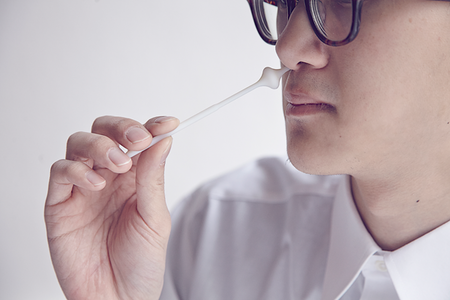
While you’re eating you will have access to both the smell and taste transformers. These utilize genetically modified miracle berries, which release enzymes that bind to your smell and taste receptors and alter your perception of the smell and taste of this rotten food.

You will be truly amazed! In just a few seconds those rotting strawberries are going to smell incredibly sweet and delicious.
 Now that you’ve learned how to use these new tools and have altered your gut bacteria, we will present our tasting menu for this evening. We start out this evening with our specialty, a San Francisco Bay-scavenged duck. We found this beauty floating on top of the water last night.
Now that you’ve learned how to use these new tools and have altered your gut bacteria, we will present our tasting menu for this evening. We start out this evening with our specialty, a San Francisco Bay-scavenged duck. We found this beauty floating on top of the water last night.
That will be followed by some roadkill prosciutto, pain moisi (that means moldy bread for the non-French speakers amongst us), some perished heirloom grapefruit, and finally rotten strawberries for dessert.
Now, let’s dig in! Bon appetit!
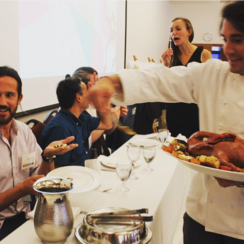
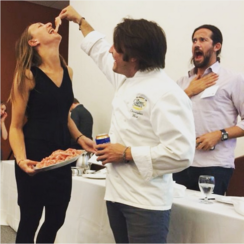
Reactions from our guests


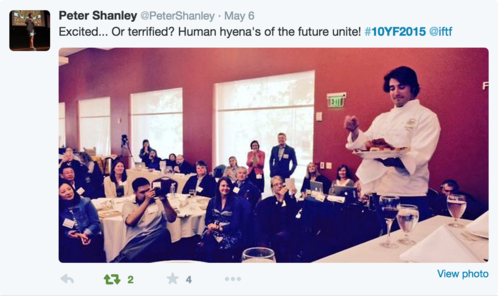

Taste the Future with IFTF
Each time we gather around the table we honor the past, experience the present, and prepare for the future. Every food choice we make today impacts the food system of tomorrow. IFTF’s Food Futures Lab hosts Edible Futures experiences to engage people in immersive tastes of possible futures and inspire them to think creatively about the future of food they want to make. For more information contact Rebecca Chesney at rchesney@iftf.org.
IFTF's Ten-Year Forecast program is a leading source of foresight for a vanguard of business, government, and community organizations. It is a platform for sensing today’s latent signals, tracking their intersections to understand the ecosystem of choices, and then designing platforms for future resilience.
Curious about the Ten-Year Forecast program?
- Follow the program at @iftf and the seven-economy forecasts at #10YF2015
- Find out more about the program
- Check out previous years' Ten-Year Forecast research
- Contact Sean Ness (sness@iftf.org)
- For more about the Food Futures Lab's research, contact Dawn Alva (dalva@iftf.org)



